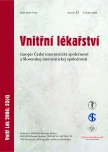Chronic nephropathies and disorders of renal function - is it sufficiently diagnosed in patients hospitalised on department of internal medicine and cardiology?
Authors:
Z. Michelová 1; M. Horáčková 1; J. Pafčugová 1; M. Hrašková 1; K. Matoušovic 1; M. Kvapil 1; J. Páleníčková 2
Authors‘ workplace:
Interní klinika 2. lékařské fakulty UK a FN Motol, Praha, přednosta doc. MUDr. Milan Kvapil, CSc.
1; Kardiologická klinika 2. lékařské fakulty UK a FN Motol, přednosta doc. MUDr. Josef Veselka, CSc., FESC, FSCAI
2
Published in:
Vnitř Lék 2006; 52(4): 308-312
Category:
Original Contributions
Overview
We have found out that nephropathies and renal dysfunctions are diagnosed insufficiently. At the same time, it has been observed that patients are sent to nephrology out-patient clinics too late. The aim of our study was to identify how nephropathy and renal dysfunction are diagnosed and how these diagnoses are recorded in diagnostic summary of hospital discharge report in patients hospitalized in department of internal medicine and cardiology of a big teaching hospital. Also, we studied the incidence of risk diseases (arterial hypertension and diabetes mellitus) and serious cardiovascular complications in individual stages of renal dysfunction. We analysed 325 medical records of patients hospitalized and discharged in the course of one month. Renal dysfunction was classified according to Kidney Disease Outcomes Quality Initiative. Glomerulal filtration rate was calculated via simplified Levey's formula. Nephropathy and renal dysfunction were diagnosed, and properly recorded in diagnostic summary, only in 5 % of patients in the Stage I of renal dysfunction (Stage II = 2%, Stage III = 28%, Stage IV = 88% and Stage V = 88%). The incidence of risk diseases and cardiovascular complications increased linearly with progression of renal insufficiency. The results of our study prove that nephropathy and renal dysfunction are diagnosed insufficiently, particularly in early stages when it is still possible to use targeted therapy and early control of specific complications of renal insufficiency.
Key words:
nephropathy – renal dysfunction – classification K/DOQI
Sources
1. Anavekar NS, McMurray JJV, Velazquez EJ et al. Relation betwen renal dysfunction and cardiovascular outcomes after myocardial infarction. NEJM 2004; 351: 1285-1295.
2. Forejt J, Horáčková M, Háša J et al. Farmakologický inzult jako příčina akutního selhání ledvin s nutností akutní hemodialyzační léčby. Vnitř Lék 2001; 47: 733-738.
3. Horáčková M, Charvát J, Háša J et al. Life threating renal failure caused by vasomotor nephropathy associated with nonsteroidal anti-inflammatory drugs. Int J Clin Pharm Res 2004; XXIV: 117-122.
4. Horáčková M, Šafářová R, Vaňková S et al. Medikamentös induzierte Nierenschädigung bei älteren Patienten. In: Lison E (ed): Werkstattgespräch Nephrologie III. Berlin: Pabst Science Publisher 2001: 30-39.
5. Chen ML, Hsu C. Controversies in Nephrology. Should the K/DOQI definition of chronic kidney disease be changed? Am J Kidney Dis 2003; 42: 623-625.
6. K/DOQI Clinical Practice Guidlines for Chronic Kidney Disease: evaluation, classification, and stratification. Am J Kidney Dis 2002; 39 (Suppl 1): S1-S266.
7. Levey AS, Beto JA, Coronado BE et al. Controlling the epidemic of cardiovascular disease in chronic renal disease: what do we know? What do we need learn? Where do we go from here? National Kidney Foundation Task Force on Cardiovacular Disease. Am J Kidney Dis 1998; 32: 853-906.
8. Levey AS, Coresh J, Balk E et al. National Kidney Foundation practice guidlines for Chronic Kidney Disease: Evaluation, Classification, and Stratification. Ann Intern Med 2003; 139: 137-147.
9. Levey AS, Coresh J. Controversies in Nephrology. Should the K/DOQI definition of chronic kidney disease be changed? Am J Kidney Dis 2003; 42: 626-630.
10. Levey AS, Green T, Kusek JW et al. A simplified eguation to predict glomerular filtration rate from serum creatinin. J Am Soc Nephrol 2000; 11: 155A.
11. McCullough PA. Cardiorenal risk: An important clinical insertion. Rev Cardiovasc Med 2002; 3: 71-76.
12. Ruilope LM, Rodicio JL. Renal participation in cardiovascular risc in essential hypertension. Blood Press 2001, 10: 322-326.
13. Tesař V. Měla by se K/DOQI definice chronického onemocnění ledvin změnit? Postgraduální Nefrologie 2003; 4: 5-7.
14. Tesař V. Některé významné novinky v klinické nefrologii v letech 2003-2004. Vnitř Lék 2004; 50(Supp 1): S81-S87.
15. Wannamethee SG, Sharper AG, Perry IJ. Serum creatinine concentration and risk of cardiovascular disease: a possible marker for increased risk of stroke. Stroke 1997; 28: 557-563.
16. Wauters JP, Lamiere N, Davison A et al. Why patients with progressing kidney disease are referred late to the nephrologist: on causes and proposals for improvement. Nephrol Dial Transplant 2005; 20: 490-496.
17. Wilson PW, D´Agostino RB, Levy D et al. Prediction of coronary heart disease using risc factor categories. Circulation 1998; 97: 1837-1847.
Labels
Diabetology Endocrinology Internal medicineArticle was published in
Internal Medicine

2006 Issue 4
Most read in this issue
- Medical videothoracoscopy in diagnosis and therapy of pleural effusions
- Primary prevention of ischemic heart disease in middle-aged men living in Prague: Results of twenty-year research
- The Prophylaxis against Venous Thromboembolic Complications in Internal Medicine - the Gap between Theory and Practice
- Ubiquitins, proteasomes, sumoylation and application today and in future for cancer and other diseases therapy I. Ubiquitin-proteasome system and the transcription factor NF-κB
